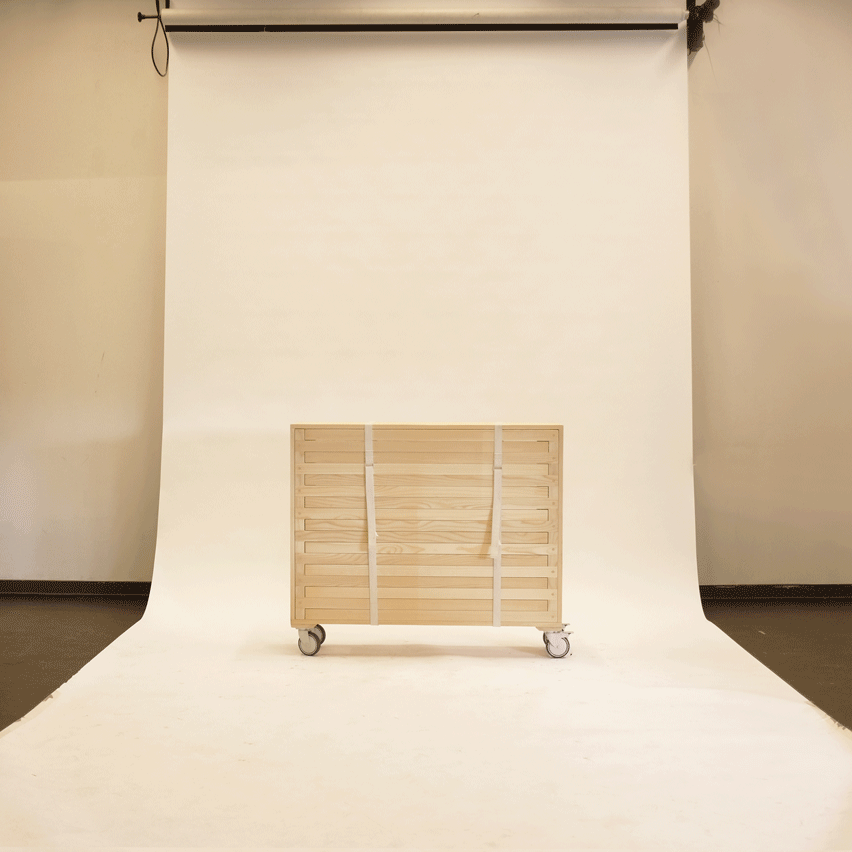
Malessa Studio's wooden NEST crate unpacks to create a bed, desk, bench and shelf designed in response to the increasingly nomadic lifestyle of young urbanites.
Amsterdam-based designer Désirée Malessa created NEST based on her own experience of moving multiple times for internships, studying and work and living in different types of rented accommodation.
"We are generation rent – a generation that is always on the move, taking possibilities wherever they might be," said Malessa.
"Accepting this nomadic lifestyle inspired me to rethink the concept of moving," she told Dezeen, "to come up with a furniture collection that can be assembled and disassembled within minutes and easily transported from place to place to place."

When fully packed away, NEST looks like a pine packing crate and measures 113 centimetres long by 85 centimetres high and 28 centimetres thick. It has optional wheels that can be attached to the bottom corners to help with the moving process.
Inside is space for personal belongings as well as a collection of flat-packed furniture pieces. At the Object Rotterdam design fair, which took place last week, Malessa showed a version that included a shelf unit, a single bed, a bench for sitting on and a table.

The name NEST stands for Nomadic Essentials for Simpler Transitions. By providing a basic kit of furniture, the collection allows its owners to personalise every space they move to with their own objects.
"Living in pre-furnished apartments made me feel like I was a guest in my own home," said Malessa. "I learned how important personal belongings are to create a known warm sense of home in an unknown new place."
"When you are moving a lot, you minimise your needs and belongings to the very basic: something to sleep on; something to sit on; a table to work and eat at; and something to store and show your belongings," explained the designer.

Drawing inspiration from Japanese minimalism and Scandinavian design, the furniture pieces are purposefully simple in appearance but can function in a variety of ways.
The length of the bed can be extended from 110 centimetres to 205 centimetres, and has optional legs, while the shelf unit is 113 centimetres long and 97 centimetres tall and the wheels from the crate can be attached to the base to raise it up and make it mobile.
The surface of the table is a lid that can lift up to turn it into a more formal workspace.

As well as offering a practical solution for frequent moving, NEST is a commentary on the housing market, overconsumption and the trend for micro-living, said Malessa.
"The prototypes and my latest version of Nest are made from second quality and sorted out pine wood from a local certified timber trader and partly out of old furniture found on our streets," she said.
"As designers, we should use design as a tool to create awareness of our society and our environment."

A growing number of designers are responding to the need for easily portable furniture pieces as young city dwellers become more mobile in the face of globalisation and a highly pressurised housing market.
Mexican designer Gerardo Osio worked with Japanese crafts workshops to create a collection of mobile homeware, while Studio Makkink & Bey created a walking stick, backpack and carrycot that could turn into living room furniture.
Elena Bompani's Itaca furniture collection can be dissassembled into a set of poles for easy transportation.
Tackling the issue from another angle, Dutch construction company Heijmans turned its attention to the high housing costs that prevent young people from settling with a prefabricated starter home than can be installed in under 24 hours.
The post NEST moving crate opens up into a minimal home kit for generation rent appeared first on Dezeen.
from Dezeen https://ift.tt/2P1owB6
No comments:
Post a Comment